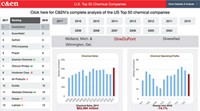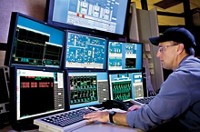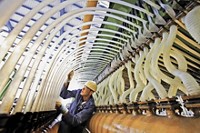Advertisement
Grab your lab coat. Let's get started
Welcome!
Welcome!
Create an account below to get 6 C&EN articles per month, receive newsletters and more - all free.
It seems this is your first time logging in online. Please enter the following information to continue.
As an ACS member you automatically get access to this site. All we need is few more details to create your reading experience.
Not you? Sign in with a different account.
Not you? Sign in with a different account.
ERROR 1
ERROR 1
ERROR 2
ERROR 2
ERROR 2
ERROR 2
ERROR 2
Password and Confirm password must match.
If you have an ACS member number, please enter it here so we can link this account to your membership. (optional)
ERROR 2
ACS values your privacy. By submitting your information, you are gaining access to C&EN and subscribing to our weekly newsletter. We use the information you provide to make your reading experience better, and we will never sell your data to third party members.
Business
Top 50 Chemical Producers
C&EN's annual ranking of U.S. chemical firms shows early strains from the economy
by Alexander H. Tullo
May 4, 2009
| A version of this story appeared in
Volume 87, Issue 18

SOMEONE SCANNING C&EN's 2009 survey of the Top 50 U.S. chemical companies for signs of the economic downturn had better squint. The evidence is there, but it is hard to find. Because the financial crisis hit late in 2008, the numbers portray an industry that was mostly still strong.
The year's survey is based on company results for full-year 2008. And sales for the 49 companies in the survey that posted comparable results actually increased by 9.6% versus 2007 to $319.6 billion.
Of 49 firms, only five posted a decrease in revenues. Eastman Chemical and H.B. Fuller had only slight declines. Georgia Gulf was hurt by its business in polyvinyl chloride, a commodity that is particularly sensitive to fluctuations in the housing market.
The other two companies with declines were Chemtura and Solutia. The former recently filed for bankruptcy, and the latter emerged from it only last year. Solutia also inked an agreement last month to sell its nylon business to the private equity firm SK Capital Partners. Solutia classified its nylon operation as discontinued for 2008, and thus the business' results weren't included in the firm's financial statements or C&EN's survey.
The strong sales results for chemical companies aren't surprising given the roller-coaster ride the industry was on last year. Chemical firms started 2008 with healthy sales volumes, but they struggled to keep prices for their products up with escalating costs for petroleum-based feedstocks. Oil prices peaked in July at about $147 per barrel.
Profits for the firms surveyed show the income-draining effects of rising oil costs. Despite the strong increase in sales, operating profits at the 46 chemical firms in the survey that reported profits tumbled by 7.1% to $28.6 billion last year. Of the 46, 20 posted a decline in profits.
The fourth quarter was one of the worst three-month periods the chemical industry has ever experienced. By then, oil prices had tumbled, taking chemical prices along with them. Meanwhile, the financial system froze as bad news on Wall Street kept getting worse. Economic activity, and thus demands for chemicals, ground to a halt.
For example, Dow Chemical, which ranks number one on the survey again this year, posted an increase in sales for the entire year of 7.5% to $57.5 billion. Its profits declined by 44.1% to $2.2 billion, but at least it posted profits. For the year's closing quarter, it generated an operating loss of $379 million. Its sales of $10.9 billion represented a decline of 23.4% versus the same quarter in 2007.
Dow's chief executive officer, Andrew N. Liveris, wrote that "2008 was a disappointing year," to shareholders in his company's annual report. He added that Dow became "vulnerable to, and was ultimately impacted by, the worst economic meltdown since the Great Depression. The fourth quarter of 2008 in particular—especially December—created an economic backdrop that negatively impacted Dow's full-year performance."
THE SURVEY is topped by the same three firms that held sway in 2008: Dow, ExxonMobil, and DuPont. PPG Industries comes in at number four with $13.9 billion in sales. Its acquisition of paint maker Sigma-Kalon helped it jump from the number six position it held in 2008. PPG edged out Chevron Phillips Chemical, which appears at number five this year, as it did last year. PPG's ranking also benefited from the disappearance of Lyondell Chemical, which left the list because it was acquired by European polyolefins maker Basell in December 2007. Incidentally, the combined company, LyondellBasell, is mired in the bankruptcy of its U.S. operations and didn't report earnings in time to make C&EN's ranking of 25 foreign-owned firms.
The industrial gas makers Praxair and Air Products & Chemicals inched higher. Praxair went from eighth to sixth, jumping over Huntsman Corp., while Air Products climbed from ninth to eighth.
Perhaps the most stunning advance in ranking was that of fertilizer maker Mosaic. Its sales increased 70% to $9.8 billion, propelling it from number 14 to number nine. This was all on the strength of sky-high fertilizer volumes and prices. Also, Mosaic's fiscal year ended May 31, 2008, so its results miss the more challenging parts of 2008.
Nevertheless, fertilizer and agricultural chemical makers tended to be the biggest movers on the list. A nearly 40% rise in sales boosted Monsanto three slots to number 18. CF Industries jumped from number 27 to 20 because of a 42% increase in sales. And Terra Industries jumped from number 34 to 29 on a 23% sales increase.
Rohm and Haas remained in the number 10 slot. It will disappear altogether in next year's survey, however, because Dow bought it last month. In contrast, Huntsman didn't become part of Hexion Specialty Chemicals last year as originally planned.
Hercules, purchased by number 32 Ashland, has disappeared from the list this year. The polyester maker Wellman, ranked 48 in the 2008 survey, didn't make the list. The company filed for bankruptcy last year and emerged as a smaller privately held company.
A few companies joined the Top 50. One is Ineos Nova, a polystyrene joint venture between Nova Chemicals and Ineos. Formed in October 2007, it had $3.9 billion in sales in 2008, enough to debut at number 21. Another big styrenics joint venture, Americas Styrenics, owned by Dow and Chevron Phillips, will likely make the list next year. Although it hasn't existed long enough to be included, it had $1.2 billion in sales last year since its formation in May.
Another new company in the survey is Olin, making its debut at number 48. The chlorine maker has seen strong growth since its 2007 purchase of competitor Pioneer Cos. And the Cranbury, N.J.-based phosphate chemicals maker Innophos debuts at 50 with $935 million in sales. The company was formerly Rhodia's phosphates business until the private equity firm Bain Capital purchased it in 2004.
In C&EN's ranking of foreign-owned firms based on their U.S. sales, BASF once again came out on top, with $17.6 billion in sales. It is followed by Shell Oil with $8.2 billion in sales.
MOST OF the changes in the Top 50 over the years come from merger and acquisition activity that gobbles up some firms while making others bigger. In recent years, private equity firms have had a dramatic impact on the list. Companies such as Rockwood and Innophos are on the list as a direct result of private equity firms constructing large companies from divisions cast off from larger firms.
More recently, the financial crisis has kept private equity firms on the sidelines, observes Paul de Janosi, managing director and head of Americas private equity at Celerant Consulting. "The financing markets for private equity have dried up," he says. "And until that comes back, you won't be seeing materially large deals involving private equity buyers."
But de Janosi still sees acquisition opportunities for industrial companies—the so-called strategic players. He says such firms are in better financial shape than private equity players because they have lower debt burdens. He adds that chemical companies are looking to shed businesses as they adjust their strategies. For example, immediately upon closing its purchase of Rohm and Haas, Dow agreed to sell Rohm and Haas's Morton Salt business to Germany's K+S.
Valuations of companies on the stock market suggest there are plenty of bargains to be had in the chemical industry. For the first time, C&EN is accompanying the Top 50 with a ranking of chemical firms based on market capitalization.
The numbers, unlike the full-year financial results, dramatically illustrate the impact of the economic downturn. On Dec. 31, 2007, the 33 companies with publicly traded shares were worth a combined $261 billion based on their stock prices. One year later, their combined value was $134 billion, a decline of 48.7%.
Of the 33, only three managed to increase their market capitalization. One is Rohm and Haas, which at the end of 2008 had an offer on the table from Dow that was far above its normal stock price. The other two were Innophos and Stepan, which have remained strongly profitable through the crisis.
LEADING THE LIST in market capitalization is DuPont, worth $22.8 billion after a 42.4% decline in its value. A year earlier, Mosaic was the largest firm in terms of market capitalization.
Three firms had market capitalization declines of more than 80%. One is Huntsman, which saw its acquisition by Hexion collapse during the year. Another is Chemtura, which declared bankruptcy earlier this year. Finally, there is the housing-exposed Georgia Gulf.
De Janosi foresees a window of opportunity when financing becomes available, but the valuation of chemical businesses is still low. Until then, job one for executives is managing their firms through the downturn and learning lessons from it. "There are companies now that are really understanding the intricacies of their businesses. In normal times, that would be a good education," de Janosi says. "In these particular times, it is a real Ph.D."
Methodology
Compiling The 50
C&EN ranks U.S. chemical producers by sales of chemicals and allied products except pharmaceuticals. Ranking the companies by chemical sales is the only way that privately held companies and some diversified producers can be included. This year, C&EN also provides a ranking of U.S. firms based on market capitalization. These are 33 companies that have listings on major U.S. stock exchanges and that generate a majority of their revenues via chemical manufacturing.
Because companies don't necessarily report chemical and nonchemical sales separately, nonchemical products often creep in. For instance, DuPont's agricultural and nutrition segment includes sales of seeds and agrochemicals. Monsanto, on the other hand, reports seeds and agrochemicals separately.
C&EN does not normally restate prior-year results other than to update foreign company results for current exchange rates or, occasionally, for changes in accounting procedures that otherwise would prevent year-over-year company comparisons. Neither does C&EN routinely restate prior-year rankings.
In the ranking of foreign-owned companies, C&EN uses sales administered by the firms' U.S. headquarters. These figures are as close to U.S. sales as possible, but companies don't post regional sales consistently. For example, Shell Oil provides sales for the U.S., whereas BASF reports them for North America. A global ranking of chemical producers is scheduled to appear in the Aug. 3 issue of C&EN.
To compile the survey, C&EN uses, for the most part, official company documents such as annual reports and 10-K filings with the Securities & Exchange Commission. For privately held and some foreign-owned companies, C&EN also interviews companies directly.









Join the conversation
Contact the reporter
Submit a Letter to the Editor for publication
Engage with us on Twitter